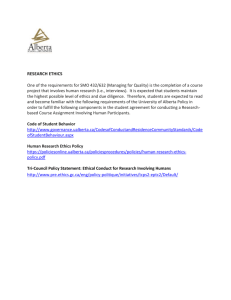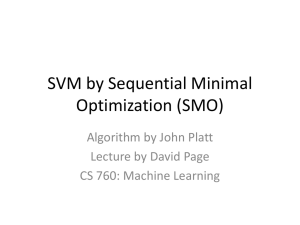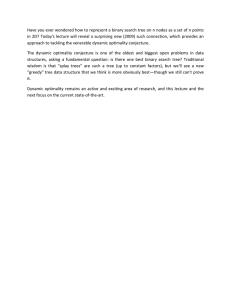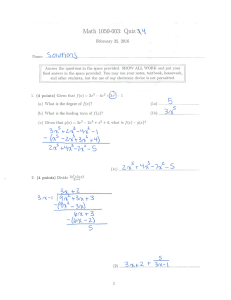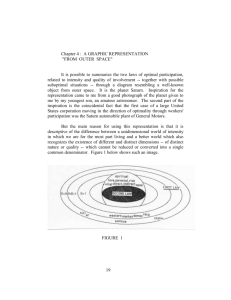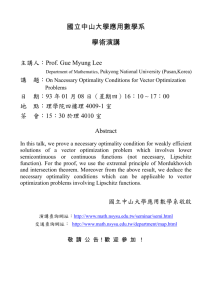Improvements to the SMO Algorithm for SVM Regression
advertisement
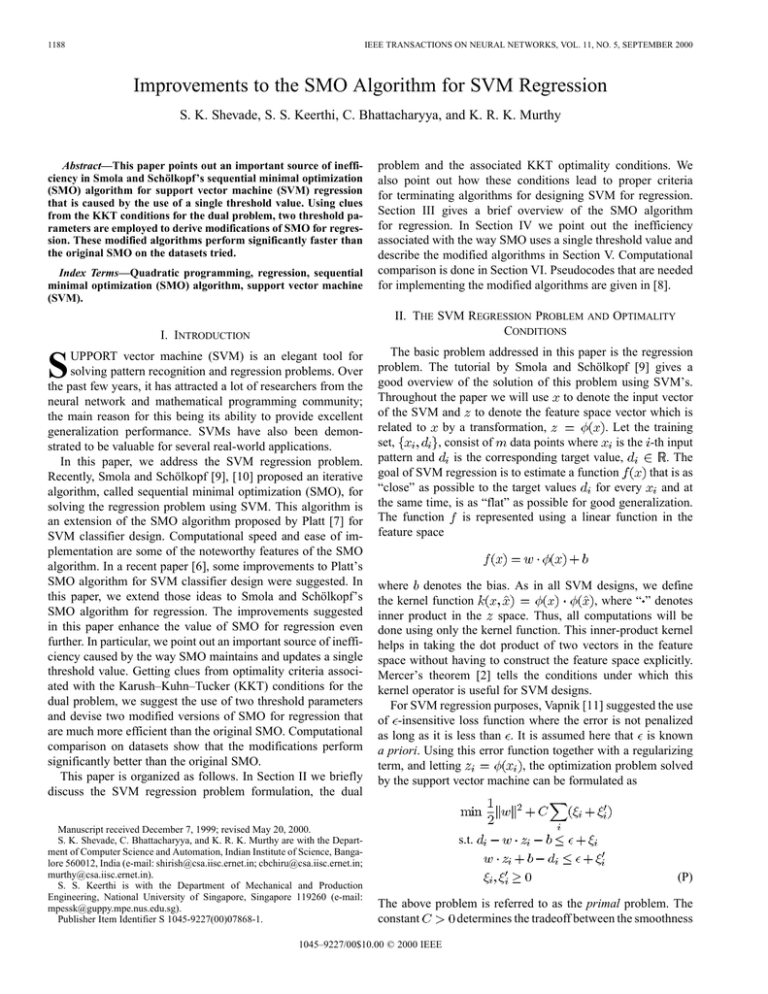
1188 IEEE TRANSACTIONS ON NEURAL NETWORKS, VOL. 11, NO. 5, SEPTEMBER 2000 Improvements to the SMO Algorithm for SVM Regression S. K. Shevade, S. S. Keerthi, C. Bhattacharyya, and K. R. K. Murthy Abstract—This paper points out an important source of inefficiency in Smola and Schölkopf’s sequential minimal optimization (SMO) algorithm for support vector machine (SVM) regression that is caused by the use of a single threshold value. Using clues from the KKT conditions for the dual problem, two threshold parameters are employed to derive modifications of SMO for regression. These modified algorithms perform significantly faster than the original SMO on the datasets tried. Index Terms—Quadratic programming, regression, sequential minimal optimization (SMO) algorithm, support vector machine (SVM). problem and the associated KKT optimality conditions. We also point out how these conditions lead to proper criteria for terminating algorithms for designing SVM for regression. Section III gives a brief overview of the SMO algorithm for regression. In Section IV we point out the inefficiency associated with the way SMO uses a single threshold value and describe the modified algorithms in Section V. Computational comparison is done in Section VI. Pseudocodes that are needed for implementing the modified algorithms are given in [8]. II. THE SVM REGRESSION PROBLEM CONDITIONS I. INTRODUCTION S UPPORT vector machine (SVM) is an elegant tool for solving pattern recognition and regression problems. Over the past few years, it has attracted a lot of researchers from the neural network and mathematical programming community; the main reason for this being its ability to provide excellent generalization performance. SVMs have also been demonstrated to be valuable for several real-world applications. In this paper, we address the SVM regression problem. Recently, Smola and Schölkopf [9], [10] proposed an iterative algorithm, called sequential minimal optimization (SMO), for solving the regression problem using SVM. This algorithm is an extension of the SMO algorithm proposed by Platt [7] for SVM classifier design. Computational speed and ease of implementation are some of the noteworthy features of the SMO algorithm. In a recent paper [6], some improvements to Platt’s SMO algorithm for SVM classifier design were suggested. In this paper, we extend those ideas to Smola and Schölkopf’s SMO algorithm for regression. The improvements suggested in this paper enhance the value of SMO for regression even further. In particular, we point out an important source of inefficiency caused by the way SMO maintains and updates a single threshold value. Getting clues from optimality criteria associated with the Karush–Kuhn–Tucker (KKT) conditions for the dual problem, we suggest the use of two threshold parameters and devise two modified versions of SMO for regression that are much more efficient than the original SMO. Computational comparison on datasets show that the modifications perform significantly better than the original SMO. This paper is organized as follows. In Section II we briefly discuss the SVM regression problem formulation, the dual Manuscript received December 7, 1999; revised May 20, 2000. S. K. Shevade, C. Bhattacharyya, and K. R. K. Murthy are with the Department of Computer Science and Automation, Indian Institute of Science, Bangalore 560012, India (e-mail: shirish@csa.iisc.ernet.in; cbchiru@csa.iisc.ernet.in; murthy@csa.iisc.ernet.in). S. S. Keerthi is with the Department of Mechanical and Production Engineering, National University of Singapore, Singapore 119260 (e-mail: mpessk@guppy.mpe.nus.edu.sg). Publisher Item Identifier S 1045-9227(00)07868-1. AND OPTIMALITY The basic problem addressed in this paper is the regression problem. The tutorial by Smola and Schölkopf [9] gives a good overview of the solution of this problem using SVM’s. Throughout the paper we will use to denote the input vector of the SVM and to denote the feature space vector which is . Let the training related to by a transformation, , consist of data points where is the -th input set, is the corresponding target value, . The pattern and that is as goal of SVM regression is to estimate a function for every and at “close” as possible to the target values the same time, is as “flat” as possible for good generalization. The function is represented using a linear function in the feature space where denotes the bias. As in all SVM designs, we define , where “ ” denotes the kernel function inner product in the space. Thus, all computations will be done using only the kernel function. This inner-product kernel helps in taking the dot product of two vectors in the feature space without having to construct the feature space explicitly. Mercer’s theorem [2] tells the conditions under which this kernel operator is useful for SVM designs. For SVM regression purposes, Vapnik [11] suggested the use of -insensitive loss function where the error is not penalized as long as it is less than . It is assumed here that is known a priori. Using this error function together with a regularizing , the optimization problem solved term, and letting by the support vector machine can be formulated as s.t. (P) The above problem is referred to as the primal problem. The determines the tradeoff between the smoothness constant 1045–9227/00$10.00 © 2000 IEEE IEEE TRANSACTIONS ON NEURAL NETWORKS, VOL. 11, NO. 5, SEPTEMBER 2000 of and the amount up to which deviations larger than are tolerated. . We will refer to Let us define as Lagrange multipliers. Using Wolfe duality theory, it the are obtained by solving the following can be shown that the Dual problem: 1189 Case 1) (1a) Case 2) (1b) Case 3) (1c) s.t. Case 4) (D) and are obtained, the primal variables, Once the and can be easily determined by using the KKT conditions for the primal problem. The feature space (and hence ) can be infinite dimensional. This makes it computationally difficult to solve the primal problem (P). The numerical approach in SVM design is to solve the dual problem since it is a finite-dimensional optimization problem. (Note that .) To derive proper stopping conditions for algorithms which solve the dual, it is important to write down the optimality conditions for the dual. The Lagrangian for the dual is (1d) Case 5) (1e) Define the following index sets at a given : . Also, let . Let us also define and as if if and if if Using these definitions we can rewrite the necessary conditions mentioned in (1a)–(1e) as (2) Let It is easily seen that the optimality conditions will hold iff there exists a satisfying (2). Let us define The KKT conditions for the dual problem are (3) Then the optimality conditions will hold at some iff (4) These conditions are both necessary and sufficient for optimality. Hereafter, we will refer to them as optimality conditions. These optimality conditions can be simplified by considering the following five cases. It is easy to check that at optimality, and cannot be nonzero at the same time. for every have been left out. Hence cases corresponding to (It is worth noting here that in the SMO regression algorithm and its modifications discussed in this paper, the condition, is maintained throughout.) There exists a close relationship between the threshold parameter in the primal problem and the multiplier, . The KKT conditions of the primal (P) and dual (D) problem imply that, at optimality, and are identical. This can be seen from the following: 1) setting the derivative of the Lagrangian of (P) with respect to to zero gives the equality constraint in (D) and 2) in , is the Lagrangian multiplier of that equality constraint; and hence, at optimality and coincide. Therefore, in the rest of the paper, and will denote one and the same quantity. defines a violation at We will say that an index pair if one of the following two sets of conditions holds: and (5a) and (5b) 1190 IEEE TRANSACTIONS ON NEURAL NETWORKS, VOL. 11, NO. 5, SEPTEMBER 2000 Note that optimality condition will hold at iff there does not that defines a violation. exist any index pair Since, in numerical solution, it is usually not possible to achieve optimality exactly, there is a need to define approximate optimality conditions. The condition (4) can be replaced by (6) where is a positive tolerance parameter. (In the pseudocodes given in [8], [10], this parameter is referred to as tol). Correspondingly, the definition of violation can be altered by replacing (5a) and (5b), respectively, by and (7a) and (7b) Hereafter in the paper, when optimality is mentioned it will mean approximate optimality. Let Using (1) it is easy to check that optimality holds iff there exists a such that the following hold for every : (8a) (8b) (8c) (8d) These conditions are used in [9], [10] together with a special choice of to check if an example violates the KKT conditions. However, unless the choice of turns out to be right, using the above conditions for checking optimality can be incorrect. We will say more about this in Section IV after a brief discussion of Smola and Schölkopf’s SMO algorithm in the next section. It is also possible to give an alternate approximate optimality condition based on the closeness of the dual objective function to the optimal value, estimated using duality gap ideas. This is fine, but care is needed in choosing the tolerance used; see [5] for a related discussion. This criterion has the disadvantage that it is a single global condition involving all . On the other hand, (7) consists of an individual condition for each pair of indexes and hence is much better suited for the methods discussed in satisfies (7) then a strict this paper. In particular, when improvement in the dual objective function can be achieved by optimizing only the Lagrange multipliers corresponding to the .) examples and . (This is true even if III. SMOLA AND SCHÖLKOPF’S SMO ALGORITHM REGRESSION FOR A number of algorithms have been suggested for solving the dual problem. Smola and Schölkopf [9], [10] give a detailed view of these algorithms and their implementations. Traditional quadratic programming algorithms such as interior point algorithms are not suitable for large size problems because of the following reasons. First, they require that the kernel matrix be computed and stored in memory. This requires extremely large memory. Second, these methods involve expensive matrix operations such as Cholesky decomposition of a large submatrix of the kernel matrix. Third, coding of these algorithms is difficult. Attempts have been made to develop methods that overcome some or all of these problems. One such method is chunking. The idea here is to operate on a fixed size subset of the training set at a time. This subset is called the working set and the optimization subproblem is solved with respect to the variables corresponding to the examples in the working set and a set of support vectors for the current working set is found. These current support vectors are then used to determine the new working set. This new set is nothing but a set of worst input data points which violate the optimality conditions for the current estimator. The new optimization subproblem is solved and this process is repeated until the optimality conditions are satisfied for all the examples. Platt [7] proposed an algorithm, called SMO for the SVM classifier design. This algorithm puts chunking to the extreme by iteratively selecting working sets of size two and optimizing the target function with respect to them. One advantage of using working sets of size two is that the optimization subproblem can be solved analytically. The chunking process is repeated till all the training examples satisfy the optimality conditions. Smola and Schölkopf [9], [10] extended these ideas for solving the regression problem using SVM’s. We describe this algorithm very briefly below. The details, together with a pseudocode can be found in [9], [10]. We assume that the reader is familiar with them. To convey our ideas compactly we employ the notations used in [9], [10]. The basic step in the SMO algorithm consists of choosing a and optimizing the dual objective funcpair of indexes, tion in (D) by varying the Lagrange multipliers corresponding to and only. We make one important comment here on the role of the threshold parameter, . As in [9], [10] and in Secdenote the output error on the th pattern. Let us tion II, let call the indices of the two multipliers chosen for joint optimization in one step as and . To take a step by varying the Lagrange multipliers of examples and , we only need to know . Therefore a knowledge of the value of is not needed to take a step. The method followed to choose and at each step is crucial for finding the solution of the problem efficiently. The SMO algorithm employs a two loop approach: the outer loop chooses ; and, for a chosen the inner loop chooses . The outer loop iterates over all patterns violating the optimality conditions, first only over those with Lagrange multipliers neither on the upper nor on the lower boundary (in Smola and Schölkopf’s ), pseudocode this looping is indicated by and once all of them are satisfied, over all patterns violating the to ensure that the optimality conditions problem has indeed been solved. For efficient implementation is maintained and updated for those indices a cache for corresponding to nonboundary Lagrange multipliers. The are computed as and when needed. remaining Let us now see how the SMO algorithm chooses . The aim is to make a large increase in the objective function. Since it is IEEE TRANSACTIONS ON NEURAL NETWORKS, VOL. 11, NO. 5, SEPTEMBER 2000 expensive to try out all possible choices of and choose the one that gives the best increase in the objective function, the or index is chosen to maximize depending on the multipliers of and . Since is available in cache for nonboundary multiplier indexes, only such indexes are initially used in the above choice of . If such a choice of does not yield sufficient progress, then the following steps are taken. Starting from a randomly chosen index, all indexes corresponding to nonbound multipliers are tried as a choice for , one by one. If still sufficient progress is not possible, all indexes are tried as choices for , one by one, again starting from a randomly chosen index. Thus the choice of random seed affects the running time of SMO. Although a value of is not needed to take a step, it is needed if (8a)–(8d) are employed for checking optimality. In the SMO algorithm is updated after each step. A value of is chosen so . If, after a step involving , as to satisfy (1) for (or both) takes a nonboundary value then (1d) or one of (1e) is exploited to update the value of . In the rare case that this , does not happen, there exists a whole interval, say, of admissible thresholds. In this situation SMO simply chooses to be the midpoint of this interval. IV. INEFFICIENCY OF THE SMO ALGORITHM The SMO algorithm for regression, discussed above, is very simple and easy to implement. However it can become inefficient because of its way of computing and maintaining a single threshold value. At any instant, the SMO algorithm fixes based on the current two indexes used for joint optimization. However, while checking whether the remaining examples violate optimality or not, it is quite possible that a different, may do a better job. So, in the SMO shifted choice of has algorithm it is quite possible that, even though reached a value where optimality is satisfied (i.e., (6)), SMO has not detected this because it has not identified the correct choice of . It is also quite possible that, a particular index may appear to violate the optimality conditions because (8) is employed using an “incorrect” value of although this index may not be able to pair with another to make progress in the objective function. In such a situation the SMO algorithm does an expensive and wasteful search looking for a second index so as to take a step. We believe that this is a major source of inefficiency in the SMO algorithm. There is one simple alternate way of choosing that involves all indices. By duality theory, the objective function value in (P) of a primal feasible solution is greater than or equal to the objective function value in (D) of a dual feasible solution. The difference between these two values is referred to as the duality gap. The duality gap is zero only at optimality. Suppose is given and . For each , the term can be chosen optimally (as a function of ). The result is that the duality gap is expressed as a function of only. One possible way of improving the SMO algorithm is to always choose so as to minimize the duality gap. This corresponds to the subproblem 1191 The solution of this subproblem is easy. Let denote the number of examples. In an increasing order arrangement of and let and be the th and -th values. The function optimized in the above minimization problem is a convex function of . The slope of this convex values smaller than , it is function is negative at all and it is zero for positive at all values bigger than . Therefore any in the interval, is and can be done a minimizer. The determination of efficiently using a “median-finding” technique. Since all are not typically available at a given stage of the algorithm, it is appropriate to apply the above idea to that subset of are available. This set contains . indexces for which We implemented this idea and tested it on some benchmark problems. The idea led to a reasonable improvement over the original SMO. However the modifications that we suggest in the next section gave much greater improvements. See Section VI for performances on some examples. V. MODIFICATIONS OF THE SMO ALGORITHM In this section, we suggest two modified versions of the SMO algorithm for regression, each of which overcomes the problems mentioned in the last section. As we will see in the computational evaluation of Section VI, these modifications are always better than the original SMO algorithm for regression and in most situations, they also give quite a remarkable improvement in efficiency. In short, the modifications avoid the use of a single threshold value and the use of (8) for checking optimality. Instead, two and are maintained and (6) (or threshold parameters, (7)) is employed for checking optimality. Assuming that the reader is familiar with [9] and the pseudocodes for SMO given there, we only give a set of pointers that describe the changes that are made to Smola and Schölkopf’s SMO algorithm for regression. Pseudocodes that fully describe these can be found in [8]. is available for all . Let 1) Suppose, at any instant, and be indices such that (9a) and (9b) Then checking a particular for optimality is easy. For example, . We only have to check if . If this suppose condition holds, then there is a violation and in that case SMO’s . takeStep procedure can be applied to the index pair Similar steps can be given for indexes in other sets. Thus, in our approach, the checking of optimality of the first index, and the choice of second index, , go hand in hand, unlike the original SMO algorithm. As we will see below, we compute and and via an efficient updating process. use 2) To be efficient, we would, like in the SMO algorithm, ; cache for spend much of the effort altering are maintained and updated to do this efficiently. And, when op, only then all indices are examined timality holds for all for optimality. 1192 3) The procedure takeStep is modified. After a successful , let . We step using a pair of indices, and using only (i.e., compute, partially, in (9)). Note that these extra steps are inexpenuse only is available and updates of sive because cache for are easily done. A careful look shows that, since and have been just involved in a successful step, each of the two and , is nonempty; hence sets, and will not be null the partially computed and could take values from and elements. Since they are used as choices for in the subsequent step (see item and also in cache. 1 above), we keep the values of , i.e., a loop with 4) When working with only , one should note that, if (6) holds at some is conpoint then it implies that optimality holds as far as cerned. (This is because, as mentioned in item 3 above, the and are influenced by all indexes in .) This choice of gives an easy way of exiting this loop. 5) There are two ways of implementing the loop involving . indexes in only Method 1: This is similar to what is done in SMO. Loop . For each , check optimality and if violated, through all then choose appropriately. For example, if . there is a violation and in that case choose Method 2: Always work with the worst violating pair, i.e., and . choose Depending on which one of these methods is used, we call the resulting overall modification of SMO as SMO-Modification 1 and SMO-Modification 2. SMO and SMO-Modification 1 are identical except in the way optimality is tested. On the other hand, SMO-Modification 2 can be thought of as a further improvement of SMO-Modification 1 where the cache is effec. tively used to choose the violating pair when holds, as already said we come 6) When optimality on . back to check optimality on all indexes Here we loop through all indexes, one by one. Since and have been partially computed using only, we update these quantities as each is examined. For a given is computed first and optimality is checked using the current and ; if there is no violation, are used and to update these quantities. For example, if , then there is a violation, in which case we take a step . On the other hand, if there is no violation, then using is modified using , i.e., if then we do: and . 7) Suppose we do as described above. What happens if there ? Can is no violation for any in a loop having we conclude that optimality holds for all ? The answer to this question is affirmative. This is easy to see from the following argument. Suppose, by contradiction, there does exist one pair such that they define a violation, i.e., they satisfy (7). Let . Then would not have satisfied the optimality us say, check in the above described implementation because either or would have, earlier than is seen, affected either the caland/or settings. In other words, even if culation of is mistakenly taken as having satisfied optimality earlier in the loop, will be detected as violating optimality when it is analyzed. Only when (6) holds it is possible for all indices to satisfy IEEE TRANSACTIONS ON NEURAL NETWORKS, VOL. 11, NO. 5, SEPTEMBER 2000 Fig. 1. Toy data: CPU time (in seconds) shown as a function of C . the optimality checks. Furthermore, when (6) holds and the loop and over all indices has been completed, the true values of , as defined in (3) would have been computed since all indices have been encountered. As a final choice of (for later use . in doing inference) it is appropriate to set: VI. COMPUTATIONAL COMPARISON In this section we compare the performance of our modifications against Smola and Schölkopf’s SMO algorithm for regression and the SMO algorithm based on duality gap ideas for threshold (see Section IV), on three datasets. We implemented all these methods in C and ran them using gcc on a P3 450 was used for all exMHz Linux machine. The value, periments. For every dataset used in the experiments, we added an independent Gaussian noise of mean zero and some standard deviation. For every dataset, the value of was manually set in a random way depending upon the amount of noise added to the data. Similar experimental approaches include [4]. The input as well as the output are then normalized so as to have zero mean and a unit variance. The first dataset is a toy dataset where the function to be ap. The doproximated is a cubic polynomial, main of this function was fixed to [ 10, 10]. The value, was used. One hundred training samples were chosen randomly. The performance of the four algorithms for the polynomial kernel where was chosen to be three (the degree of the polynomial from which the data is generated), is shown in Fig. 1. The second dataset is the Boston housing dataset which is a standard benchmark for testing regression algorithms. This dataset is available at UCI Repository [1]. The dimension of the input is 13. We used a training set of size 406. The value, was used. Fig. 2 shows the performance of the four algorithms on this dataset. For this as well as the third dataset the Gaussian kernel IEEE TRANSACTIONS ON NEURAL NETWORKS, VOL. 11, NO. 5, SEPTEMBER 2000 1193 ciency is remarkable. In particular, at large values of the improvement is by an order of magnitude. Between the two modifications, it is difficult to say which one is better. The primary purpose of these experiments is to examine differences in training times of all the four methods. However, studying the generalization abilities of these methods is an important task and we are currently investigating it. The results of this comparison will be reported elsewhere. VII. CONCLUSION Fig. 2. Boston housing data: CPU time (in seconds) shown as a function of C . In this paper, we have pointed out an important source of inefficiency in Smola and Schölkopf’s SMO algorithm that is caused by the operation with a single threshold value. We have suggested two modifications of the SMO algorithm that overcome the problem by efficiently maintaining and updating two threshold parameters. Our computational experiments show that these modifications speed up the SMO algorithm significantly in most situations. The modifications can be easily implemented using the pseudocodes given in [8]. REFERENCES Fig. 3. Comp-Activ data: CPU time (in seconds) shown as a function of C . was used and the value employed was 2.5. The value of was chosen randomly. The SVM is rather insensitive to different choices of . The third dataset, Comp-Activ, is available at the Delve website [3]. This dataset contains 8192 data points of which we used 5764. We implemented the “cpuSmall” prototask, which involves using 12 attributes to predict the fraction of time (in for this percentage) the CPU runs in user mode. We used dataset. The performance of the four algorithms on this dataset is shown in Fig. 3. It is very clear that both modifications outperform the original SMO algorithm. In many situations the improvement in ef-fi- [1] C. L. Blake and C. J. Merz. (1998) UCI Repository of Machine Learning Databases. Univ. California, Dept. Inform. Comput. Sci., Irvine, CA. [Online]. Available: http://www.ics.uci.edu/~mlearn/MLRepository.html [2] C. J. C. Burges, “A tutorial on support vector machines for pattern recognition,” Data Mining Knowledge Discovery, vol. 3, no. 2, 1998. [3] Delve: Data for Evaluating Learning in Valid Experiments [Online]. Available: http://www.cs.utoronto.ca/~delve [4] O. L. Mangasarian and D. R. Musicant. (1999, Aug.) Massive Support Vector Regression. [Online] . Available: ftp://ftp.cs.wisc.edu/pub/dmi/tech-reports/99-02.ps [5] S. S. Keerthi, S. K. Shevade, C. Bhattacharyya, and K. R. K. Murthy, “A fast iterative nearest point algorithm for support vector machine classifier design,” IEEE Trans. Neural Networks, vol. 11, pp. 124–136, Jan. 2000. , (1999, Aug.) Improvements to Platt’s SMO Algorithm for SVM [6] Classifier Design, Accepted for Publication in Neural Computation. Control Division, Dept. of Mechanical and Production Engineering, National University of Singapore, Singapore. [Online]. Available: http://guppy.mpe.nus.edu.sg/~mpessk [7] J. C. Platt, Advances in Kernel Methods: Support Vector Machines, B. Schölkopf, C. Burges, and A. Smola, Eds. Cambridge, MA: MIT Press, Dec. 1998. Fast training of support vector machines using sequential minimal optimization. [8] S. K. Shevade, S. S. Keerthi, C. Bhattacharyya, and K. R. K. Murthy. (1999, Aug.) Improvements to SMO Algorithm for Regression. Control Division, Dept. of Mechanical and Production Engineering, National University of Singapore, Singapore. [Online]. Available: http://guppy.mpe.nus.edu.sg/~mpessk [9] A. J. Smola, “Learning with Kernels,” Ph.D. dissertation, GMD, Birlinghoven, Germany, 1998. [10] A. J. Smola and B. Schölkopf, “A Tutorial on Support Vector Regression,” Royal Holloway College, London, U.K., NeuroCOLT Tech. Rep. TR 1998-030, 1998. [11] V. Vapnik, The Nature of Statistical Learning Theory. New York: Springer-Verlag, 1995.
